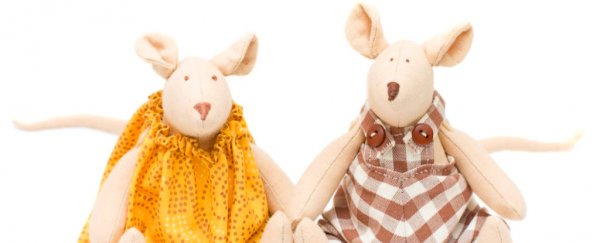She squeaks in ultrasound, "I love you". He chirrups back "Right back at ya', sweetheart". It's all in the dulcet tones of California mice, but the meaning is clear.
Then one of them spends time with another mouse spouse. Later, partners reunited, there's tension. Somebody barks. A high pitched roar. They'll make up later, but right now, Mr and Mrs Mouse are having marriage problems.
Anthropomorphic interpretations aside, the strictly monogamous California mouse (Peromyscus californicus) presents eerily familiar vocalisations post-separation, according to a study by researchers from the University of Wisconsin-Madison.
Apparently monogamy, jealousy, and marital fights might not be as uniquely human as we think.
While many species of mouse might utter the occasional audible high-pitched squeak every now and then, many of the sounds made by these tiny mammals are beyond our ability to hear.
Our ears can only detect sounds up to around 20 kilohertz. That means we need to pay extra close attention using special equipment to record and analyse their communication, which hits a pitch of up to 250 kilohertz.
California mice make for a rather interesting case study as far as rodent chatter goes.
Not only do they pair up for life in a mating relationship, dad sticks around to raise the kids. They're also fiercely territorial, making them the quintessential suburban nuclear family of the rodent world.
That similarity goes beyond familial relationships.
"Like it or not, we have a very similar basic system, hormonally and brain-wise," the study's lead author Joshua Pultorak told Leslie Nemo at National Geographic.
To better understand their social connections, the researchers recorded the ultrasound squeaking and movements of 110 mice paired up in cages.
The sounds consisted of chirping calls, which – slowed to a human-friendly frequency – sounded almost canary-like, as well as some wailing that wasn't unlike a dog's howl.
According to the researchers, these are the sounds of domestic murine bliss, the mouse equivalent of no, I love you more.
They then set about dividing some of the mice up, placing a handful in solitary confinement and others into cages with mice of the opposite sex for about a week in the mouse equivalent of cheesy, lurid reality television.
If there was any bed-hopping going on, the researchers weren't paying attention. That wasn't the point. Their goal was to see what would happen when the pair-bonded mice were all put back together again.
For mice that hadn't been separated, and those that had spent time alone, life went on as usual. All kissy-chirps and happy-howls.
For roughly half of those which had spent seven days in the company of another? Not so much.
On meeting, their ultrasound conversations were tense. There was aggression. Howls of joy were more like demonic barks of terror. Really, there's no sound like a mouse scorned.
In time, life returned to normal for those who had starring roles in laboratory Mice Swap. Love bloomed again, though for some, reconciliation simply took a little longer.
Returning relatively quickly to serenity or avoiding aggression and barking vocalisations was highly correlated with good paternal bonds and healthy offspring.
As with humans, it's likely there's some complex social behaviour going on that explains this connection between mouse communication and reproductive health.
Interpreting all this through a human lens – as amusing as it might be – can risk unsupported assumptions. So as always, it's a good start for some fertile research in the future to further tease out the details.
Still, humans and mice do have a lot in common. Insight into their relationships just might point the way to new discoveries in our own.
Might we recommend the next one involve a single male rodent picking from a line-up of potential mates?
We could call it The Ratchelor…
This research was published in Frontiers in Ecology and Evolution.
